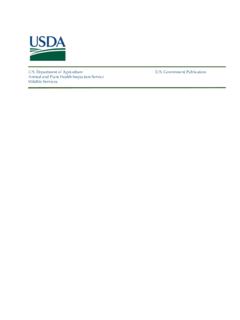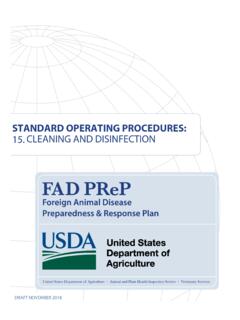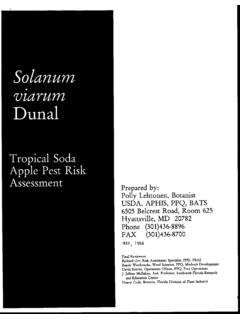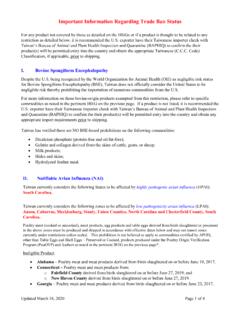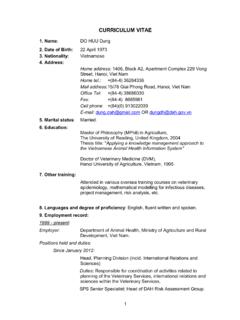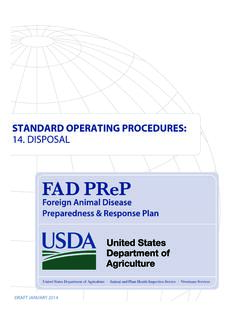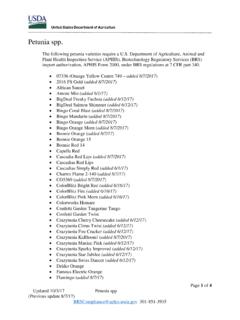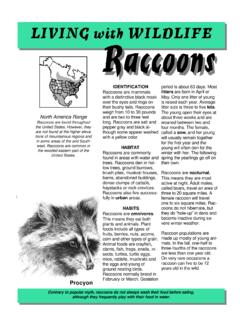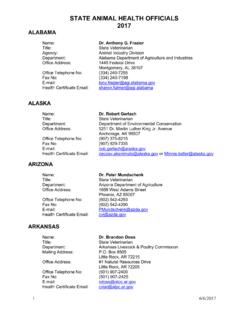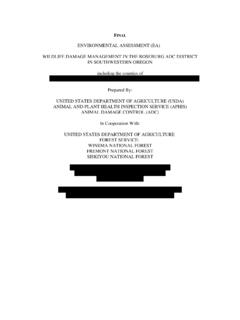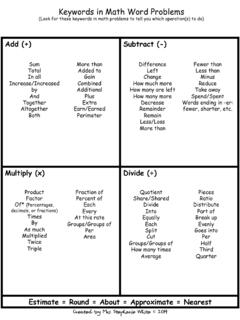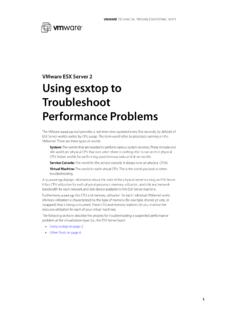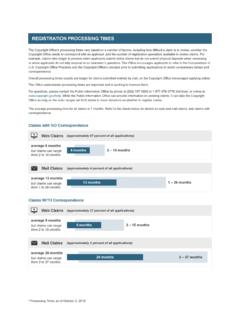Transcription of Mute Swans - USDA
1 David R. Marks District Supervisor usda -APHIS Wildlife Services Urbandale, Iowa Human-Wildlife Conflicts Mute Swans (Cygnus olor, Figure 1) are an invasive species originally brought to the United States in the late 19th and early 20th centuries for ornamental ponds and lakes, zoos and aviculture collections. Original populations were located in northeastern states along the Hudson Valley but have since expanded to several Midwestern states and portions of the western and Canada. Mute swan damage includes competing with native waterfowl, destroying native plants, spreading disease, and colliding with aircraft. They are also considered a nuisance in some areas due to their abundant fecal droppings and aggressiveness towards people.
2 Natural Resources Mute Swans can impact ecosystems by foraging on native plants and competing with native species for food and habitat. Mute Swans forage primarily on submerged aquatic vegetation, and each swan consumes 4 to 8 pounds of vegetation per day. While feeding, mute Swans use their feet to expose plant shoots and roots for foraging, and to help dislodge food for cygnets ( , young Swans ). This damages aquatic substrates and vegetation surrounding preferred foods. Mute Swans typically consume less than 50 percent of what they remove. Results from one study showed their diet overlaps considerably with many native Wildlife Damage Management Technical Series Department of Agriculture Animal & Plant Health Inspection Service Wildlife Services February 2018 Mute Swans Figure 1.
3 Adult mute swan (Cygnus olor). Quick Links Human-Wildlife Conflicts 1 Damage Identification 3 Management Methods 3 Economics 8 Species Overview 8 Legal Status 11 Glossary & Key Words 12 Resources 13 Appendix 14 waterfowl species that overwinter in the lower Great Lakes or temporarily use the area during migration. Mute Swans are known for their highly territorial behavior during their breeding season, and may compete with native wildlife for space and associated resources. Of particular concern are potential impacts on threatened and endangered species. During the breeding season, mute Swans sometimes displace other native waterfowl from preferred nesting locations, and may kill adult and juvenile ducks and geese (Figure 2).
4 During one incident in Maryland, a large molting flock of mute Swans caused a colony of least terns (Sterna antillarum) and black skimmers (Rynchops niger) to abandon a nesting colony by trampling nests, eggs, and chicks. The mute Swans also displaced nesting common terns (Sterna hirundo). In 2011 in Michigan, a mute swan nest was found in the middle of a black tern (Chlidonias niger) colony that had previously supported approximately 54 black terns in 2009. Only a few black tern nests remained, approximately 30 to 40 feet away from the swan nest. Agriculture In some portions of the world, mute Swans damage agricultural crops, such as wheat and oilseed rape.
5 In the , however, incidents of swan damage to crops are rare. Mute Swans may serve as vectors or reservoirs for diseases of significance to agriculture, such as Newcastle disease and avian influenza. A 2014 study showed that 60 percent and 45 percent of the mute Swans sampled had been exposed to Newcastle disease virus and avian influenza virus, respectively. Human Health and Safety While the transmission of diseases or parasites from waterfowl to people has not been well documented, various studies indicate that the potential exists. In worst case scenarios, infections may be life-threatening for immunocompromised people.
6 Diseases that potentially may be transmitted through mute swan feces to people include swimmer s itch, salmonellosis, and E. coli infections. However, scientists at the Centers for Disease Control and Prevention estimate the risk of such infections is low. Costs associated with disease issues and mute Swans can be high and include the following: testing of water for coliform bacteria regularly cleaning feces from beaches and other recreational areas lost revenue associated with recreational sites that are temporarily closed because of fecal contamination consultation with public health officials implementing nonlethal and lethal mute swan damage management methods In addition to disease issues, mute Swans also threaten air safety.
7 Bird strikes usually kill birds and can damage aircraft, disrupt airport operations, and erode public confidence in the safety of air travel. Mute swan collisions with aircraft not only risk human safety, but also result in expensive damage to aircraft, loss of aircraft due to repairs, and monetary losses due to flight cancellations and delays. In the from 1994 to 2011, there were eight reported mute swan bird strikes. Although this number is low compared to other species, the size of mute Swans makes them particularly hazardous to aircraft. In areas with high numbers of mute Swans , attacks on people and pets have become more frequent.
8 Mute Swans defend their nests, nesting areas, and young from any Page 2 WDM Technical Series Mute Swans Figure 2. Mute swan showing aggression toward a mallard. perceived threats, including people and pets. Birds that are fed by people may become aggressive in seeking food. Most of the aggressive behavior involves displaying dominant postures and making hissing noises, without making physical contact (called bluffing). However, mute Swans are capable of inflicting bruises, sprains and bone fractures. In at least one case in Illinois, a mute swan attack resulted in a human fatality. A man in a kayak ventured too close to a mute swan nest; the swan attacked and caused the man to capsize the kayak.
9 The man was not wearing a personal floatation device and witnesses reported the swan continued to attack as the man tried to keep his head above water. Nuisance Most conflicts between mute Swans and people affect people s enjoyment of recreational sites or activities. People often cannot use and enjoy their own property, public parks and other areas because of aggressive Swans or the accumulation of swan feces. Costs associated with mute swan nuisance problems include labor and disinfectants to clean and sanitize areas, loss of property use and resale value, loss of aesthetic value of aquatic vegetation in areas where mute Swans nest, loss of customers or visitors fearful of swimming in waters with swan feces or of being attacked by aggressive Swans and implementation of wildlife management methods.
10 Damage Identification Most mute swan damage is difficult to attribute to the species unless the birds are actually observed causing the damage. For instance, competition with other waterfowl for breeding or food resources may not be readily seen. Observable mute swan damage includes destruction of submerged and emergent aquatic vegetation. Mute Swans typically consume only about 50 percent of the material they uproot or damage during feeding, therefore, remnant vegetation is often floating in areas where mute Swans have fed. Although damage to submerged aquatic vegetation may be difficult to assess because it occurs underwater, it may become apparent as remnant vegetation accumulates along shorelines and beaches.
